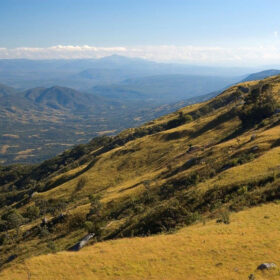On safari in Malawi
Most trips in Malawi start in Blantyre or Lilongwe. These are cities with good connections and international airports. For on-site transportation, there are two options: being driven by guide or driver in a comfortable safari car, or by small plane from accommodation to accommodation (a so-called fly-in safari). From Blantyre, Mount Mulanje, Majete Wildlife Reserve and Liwonde can be easily visited; the areas are a relatively short distance from each other, and the drives between accommodations are versatile and give an insight into the daily lives of Malawians.
The parks in northern and central Malawi are more accessible from Lilongwe, and certainly where Nyika and Likoma Island are concerned. There are regular flights from Lilongwe to these more remote areas. Another great combination is a visit to South-Luangwa in Zambia; there is a good flight connection between the small Mvuu Airport near South Luangwa and Lilongwe International Airport.
Activities in Malawi are diverse: traditional safari experiences with game drives, mountain bike trails, walks on the plateaus and mountains of the Mulanje Massif, water sports and SCUBA diving in and around Lake Malawi … Malawi offers something for everyone.
Accommodations around Lake Malawi
Definitely worth mentioning. There are several fine accommodations around Lake Malawi, where one can relax, but also spend a more active stay. Swimming, diving and snorkeling are obvious, of course. For example, check out Chinteche Inn or Mumbo Island. On the east side of the lake, a little more secluded, you can also find some luxury accommodations. Nkwichi Lodge (on the Mozambican side) and Kaia Mawa on Likoma Island can quietly be called paradisiacal!
Nature reserves in Malawi
Check out some of the parks in Malawi:
Nyika National Park
In the far north of Malawi lies Nyika National Park, Malawi’s largest park with an area of over 3,000 km2. The high-altitude area is rugged, pristine and remote, making it the only Afro-montane nature reserve in south-central Africa. The area resembles the Scottish Highlands with spectacular panoramas, high grasslands, hills and evergreen forests. It is teeming with native animals. Nyika can be labeled a botanist’s paradise, especially in summer, with a multitude of flowers, including 11 locally occurring orchids, animal lamas, gladiolus, protea and kniphofia. The populations of roan, eland, zebra, reedbuck, and bushbuck are well worth seeing. Hunters such as hyena, jackal, and leopard can also be seen there. For birders Nyika is also fantastic , there are about 400 species of birds found in Nyika, several of which are found almost exclusively in that area.
Lake Malawi National Park
Lake Malawi occupies nearly one-third of narrow Malawi. Known for its enormous variety of fish species, the often crystal clear lake is home to a greater number of freshwater fish (more than 1,000) than any other lake on earth. To illustrate, this number is more than all the freshwater fish species of Europe and North America combined. Much of the stunning underwater diversity is protected within Lake Malawi National Park at Cape Maclear in the southern part of the lake. The park is the first in the world specifically dedicated to protecting freshwater fish. It has also been designated a World Heritage Site.
Liwonde National Park
Covering an area of 548 km2, Liwonde National Park is considered the most prominent nature reserve in Malawi. The western boundary of the park is formed by the Shire River, the largest river in the country and the only outlet of Lake Malawi. In and around the river are large concentrations of hippos, crocodiles and elephants. The extensive floodplains around the river provide dense riverine flora and many borassus palms and baobabs. Antelope such as impala, waterbuck, reedbuck and bushbuck are common on the banks.
The eastern part of the park is characterized by relatively dry Mopane vegetation interspersed with candelabra trees. Favored among buffalo, yellow baboon and Lichtenstein’s hartebeest. The sable antelope population is one of the most dense in Africa. In addition, a group of black rhinos reside in the park in a special project to protect this extremely vulnerable species. Birdwatchers are also well catered for in Liwonde.
Majete Wildlife Reserve
Majete Wildlife Reserve is one of the most telling and successful examples of wildlife restoration through proper protection and management. Before the efforts, the area had been reduced to a lifeless patch of forest where virtually no animal could be found. Partly because of the war in neighboring Mozambique, poaching was the order of the day, and species after species were being exterminated. From the moment African Parks took over the management of the area, it has been restored with enormous effort to its original state with all the animals that originally belonged there. The result is stunning: a magnificent park, with fantastic wildlife population and an important cornerstone in the economy and development of the local communities. Be sure to ask the scouts about the history. A visit to the “Confiscation Room” is also well worthwhile. Here all confiscated poaching materials are stored: proof of the effectiveness and necessity of all efforts to protect Majete..















